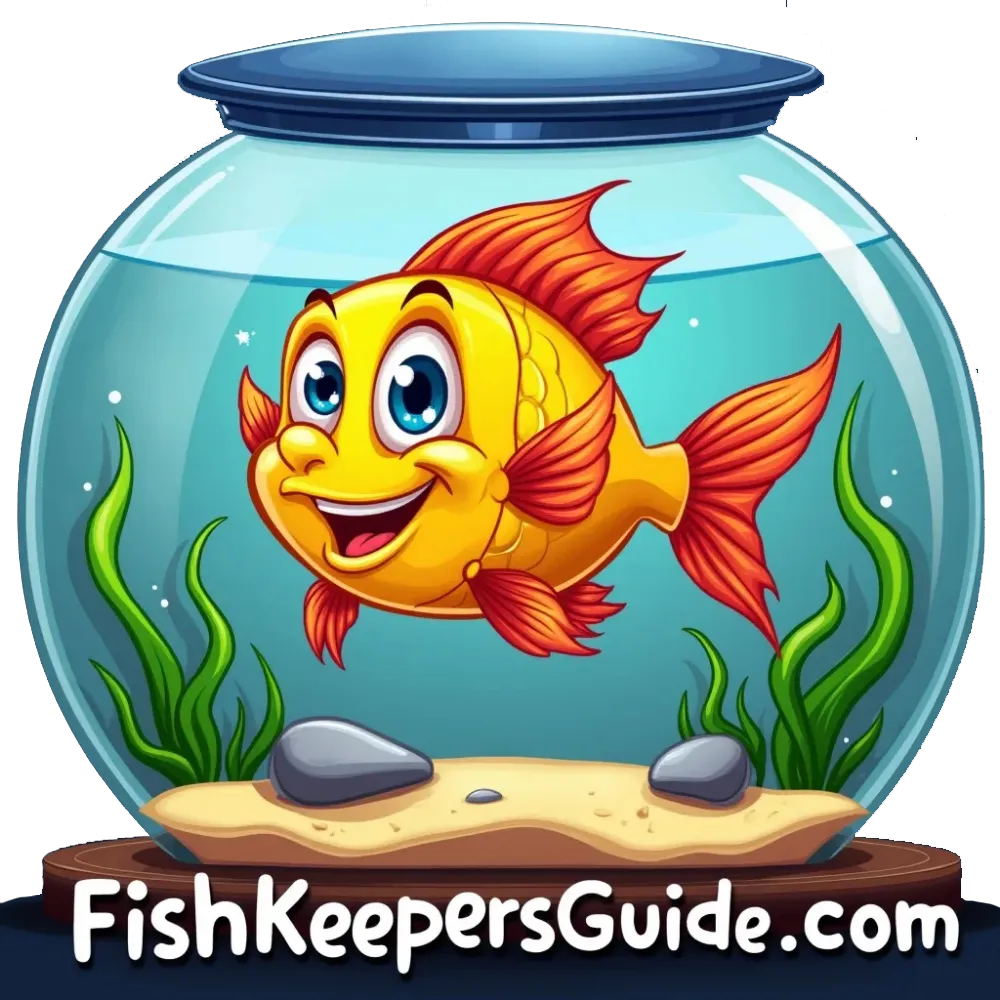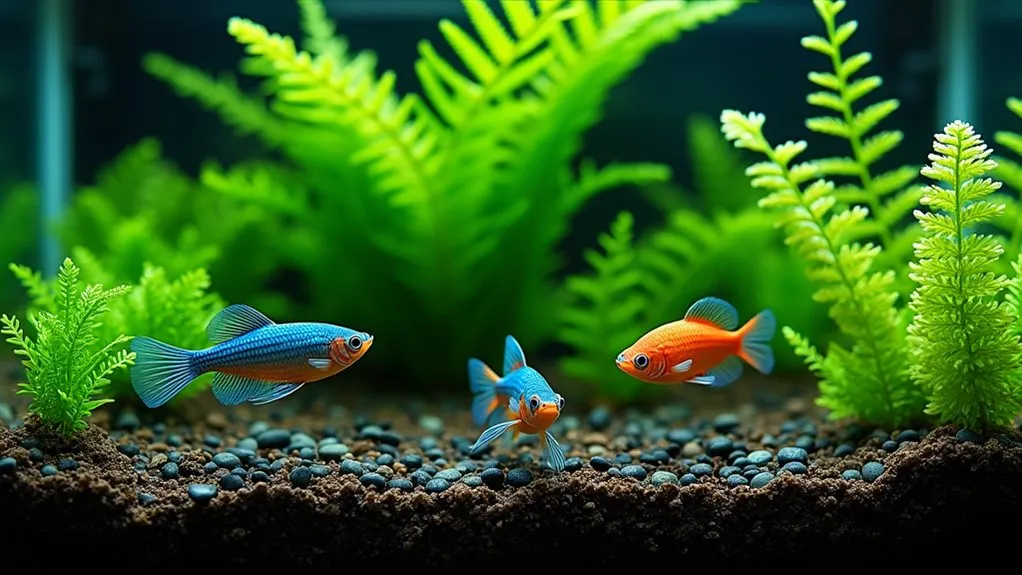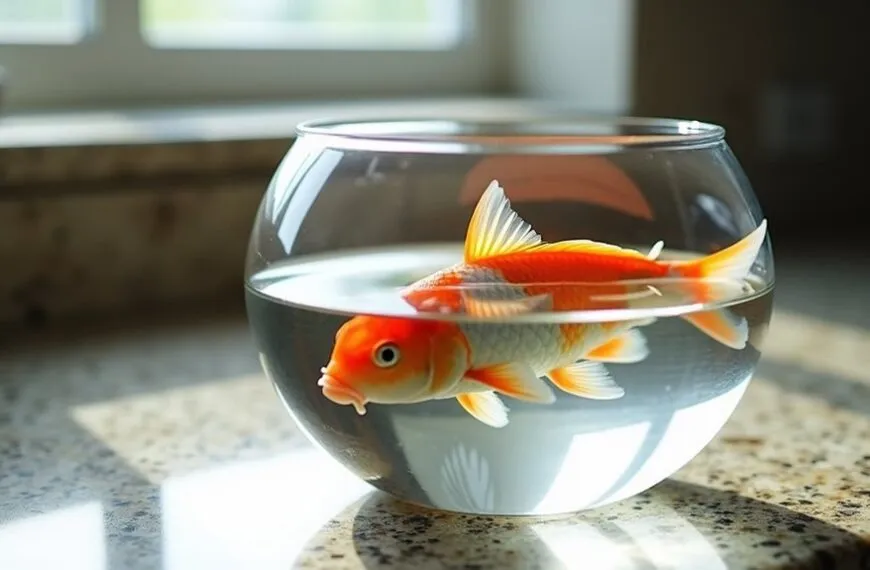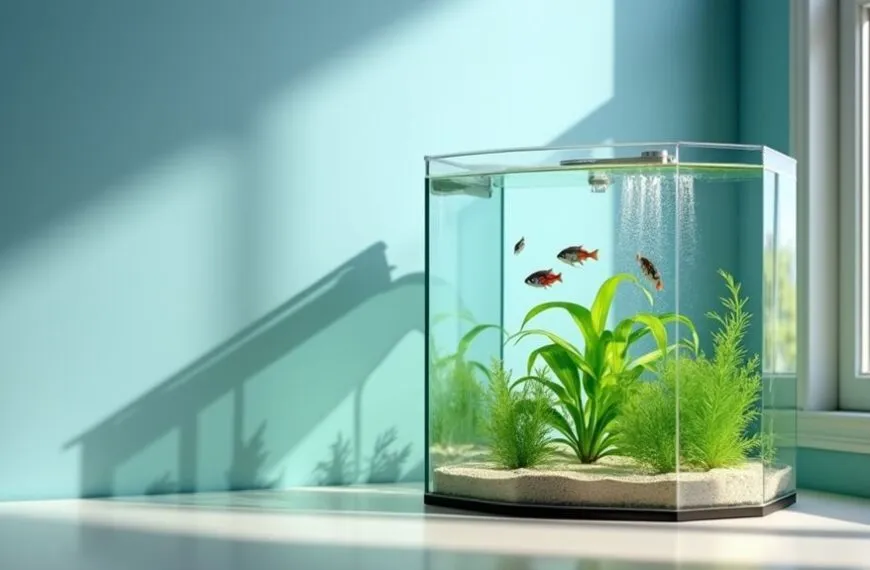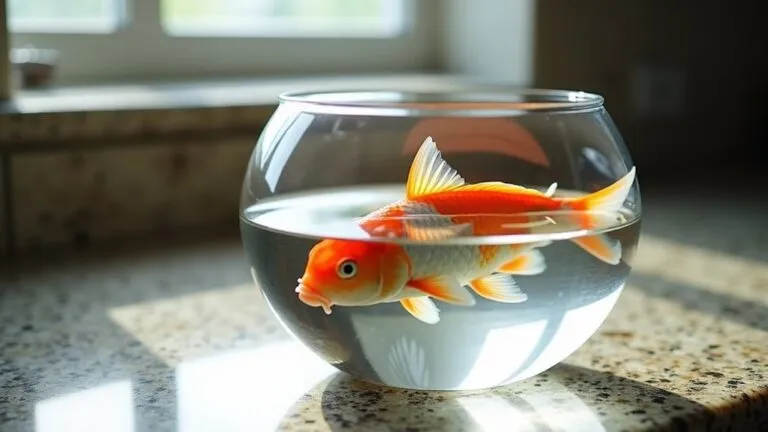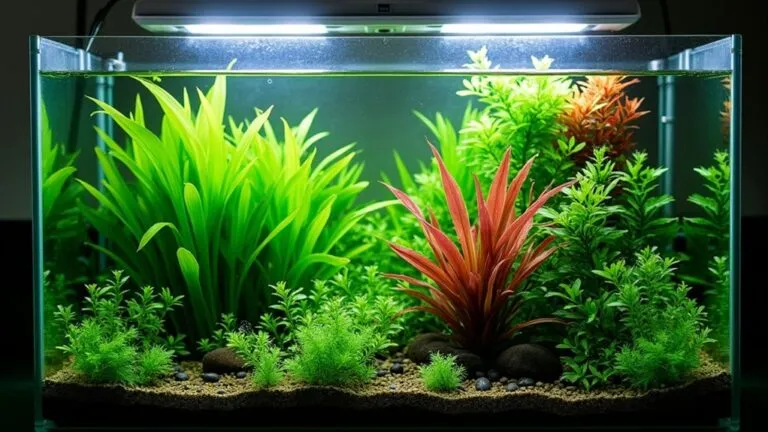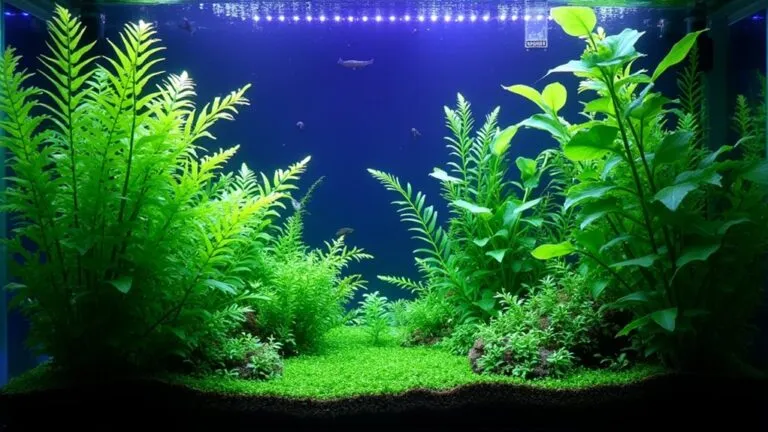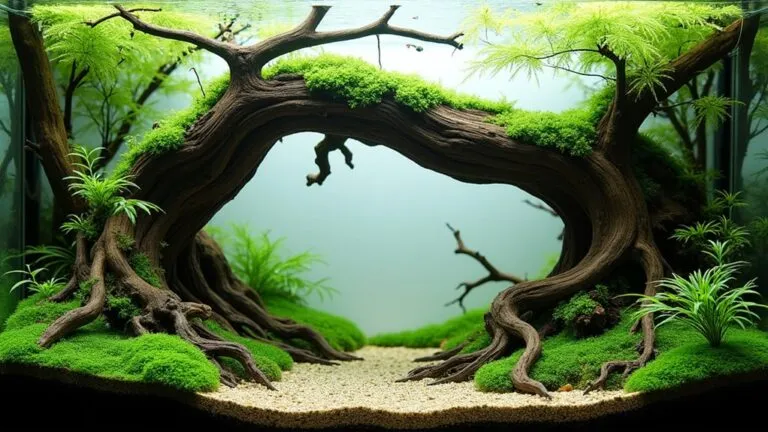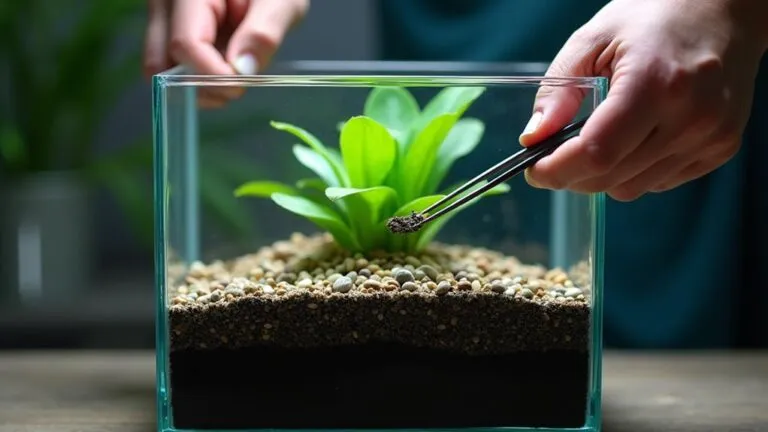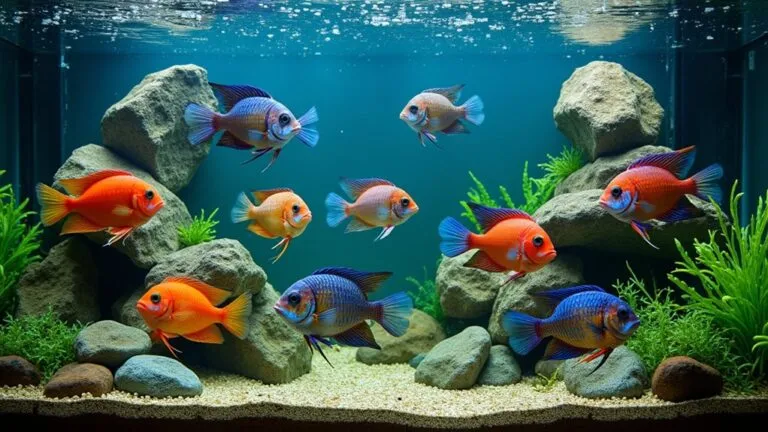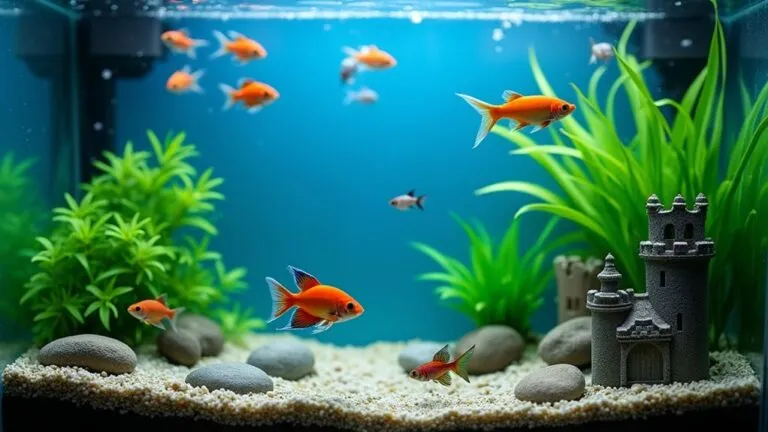The easiest fish to care for are tetras, rasboras, and danios – they're hardy little swimmers that won't give you grief. You'll love how these peaceful fish adapt well to small environmental changes and don't need complicated feeding routines. Consider starting with neon tetras or white cloud mountain minnows if you've got limited space, as they thrive in tanks as small as 10 gallons. Guppies and platies add vibrant colors while staying low-maintenance, and cory catfish help keep your tank clean as natural bottom-feeders. There's much more to discover about these fascinating, easy-care aquatic pets.
Contents
- 1 Understanding Low-Maintenance Fish
- 2 Top Fish for Beginners
- 3 Tank Setup Requirements
- 4 Feeding and Dietary Needs
- 5 Water Quality Management
- 6 Best Fish Tank Combinations
- 7 Daily Care Routines
- 8 Disease Prevention Tips
- 9 Schooling Fish Benefits
- 10 Seasonal Care Guidelines
- 11 Frequently Asked Questions
- 11.1 Can Low-Maintenance Fish Recognize Their Owners?
- 11.2 Do These Fish Need Additional Lighting Besides Room Light?
- 11.3 How Long Do Most Low-Maintenance Fish Typically Live?
- 11.4 Can Low-Maintenance Fish Breed Easily in Home Aquariums?
- 11.5 Should Low-Maintenance Fish Be Quarantined Before Joining Existing Tanks?
- 12 Final Thoughts
Understanding Low-Maintenance Fish
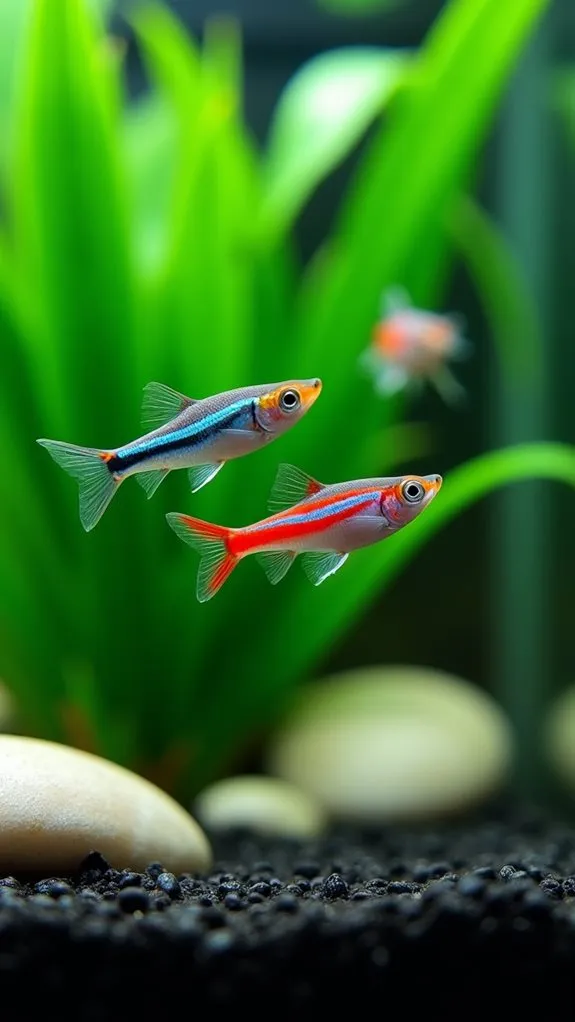
For those seeking a hassle-free aquarium experience, low-maintenance fish offer an ideal solution. When you're choosing your aquatic companions, you'll want to understand what makes certain fish easier to care for than others.
These hardy swimmers can handle small changes in their environment without getting stressed, which is perfect if you're new to the fish-keeping hobby or just prefer a more relaxed approach to tank maintenance. Keeping these fish can provide natural stress relief as you watch them glide through the water. Furthermore, many low-maintenance species can thrive in minimum tank sizes of just 10 gallons, making them accessible for beginners.
You'll find that low-maintenance fish typically display predictable fish behavior patterns that make them a joy to watch. They're often peaceful creatures that won't start underwater drama in your tank, and they'll adapt well to various water conditions. Popular choices like betta fish and goldfish are beginner-friendly options that can thrive in various water temperatures.
Plus, they're not picky eaters – most are happy with a simple once-a-day feeding schedule. When it comes to tank aesthetics, you won't need elaborate setups or fancy equipment to keep these fish healthy and happy. A basic filter, appropriate lighting, and some simple decorations will do just fine.
The best part? Many low-maintenance fish are perfectly content in smaller tanks, making them ideal for apartments or office spaces where space might be limited.
Top Fish for Beginners
When starting your aquarium journey, several fish species stand out as particularly beginner-friendly. You'll find that tetras, rasboras, and danios are incredibly hardy choices that'll thrive in your new tank setup. These fish require simple tank care with just regular feeding and basic water changes.
According to expert data, these species are among the 37,106 valid species currently documented in ichthyology databases.
These schooling fish aren't just tough – they're also fascinating to watch as they swim together in groups.
If you're concerned about fish compatibility, you can't go wrong with peaceful species like platies and guppies. They're colorful, easy-going, and won't cause drama in your aquarium – think of them as the perfect neighbors!
Bettas deserve special mention, as they can be kept alone or with other peaceful fish, making them surprisingly versatile beginner fish.
For those with limited space, neon tetras and white cloud mountain minnows are excellent choices. They're compact but full of personality, and they'll make the most of smaller tanks.
Don't forget about cory catfish – these bottom-dwelling cleaners are like tiny maintenance crews for your tank. They're peaceful, hardy, and they'll help keep your aquarium looking tidy while providing endless entertainment with their bustling activity.
Tank Setup Requirements
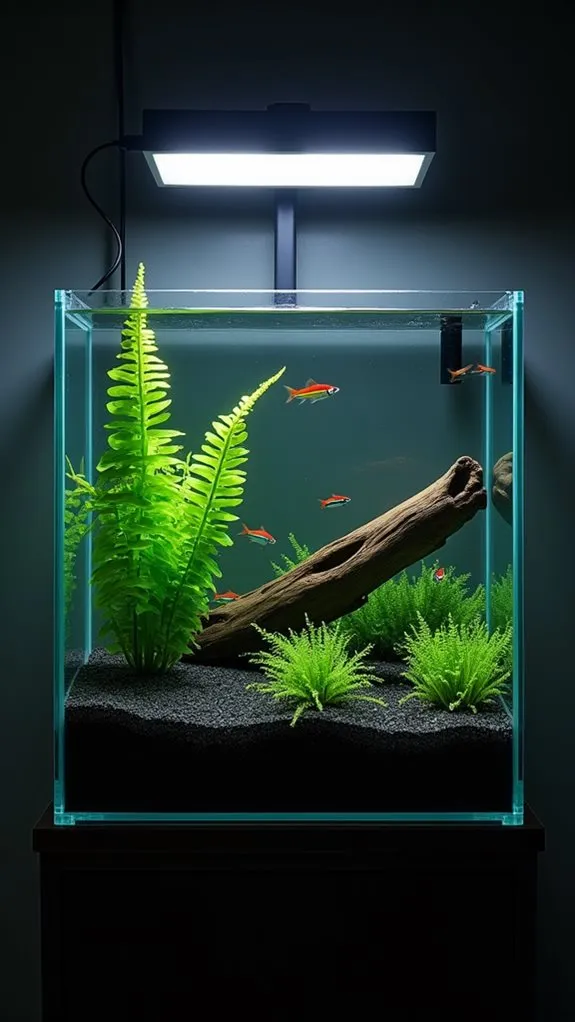
You'll want to start with a larger tank (at least 20 gallons) since it's actually easier to maintain than a smaller one and gives you more room for error.
Your essential equipment includes a robust filtration system that's slightly oversized for your tank, proper LED lighting on a timer, and a substrate that's at least 10cm deep for healthy plant growth. Setting up your LED lighting at 0.1W/L intensity will help prevent algae issues while promoting steady plant growth. Using an established filter media from another tank can help speed up the cycling process significantly. Additionally, a good heater is crucial to ensure consistent temperature regulation, especially for tropical fish.
Before adding any fish, you'll need to set up your hardscape elements and establish a thriving plant environment, which will create a stable ecosystem that requires less maintenance down the road.
Essential Equipment Needs
Setting up a low-maintenance fish tank requires specific equipment essentials to create a stable, healthy environment.
A Fluval Aquarium Kit is an excellent 16-gallon starter option that includes most necessary components.
You'll want to start with the right tank materials – while glass tanks are scratch-resistant and sturdy, acrylic ones offer better insulation but might show scratches more easily. A proper test kit including pH, Nitrate, Nitrite, and Ammonia tests is essential for monitoring water parameters.
When it comes to filtration systems, biological filtration is absolutely vital for breaking down toxic ammonia and keeping your finned friends happy.
You'll need a reliable heater to maintain a steady temperature around 78°F for tropical fish – consider an in-line heater as it's the safest option with minimal risk of fish contact.
Don't forget a thermometer to monitor those temps! For water circulation, you can choose between air pumps and powerheads, depending on your tank size.
If you're going with a smaller setup, a simple hang-on filter might do the trick for both filtration and surface agitation.
Remember to grab some essential maintenance tools like a siphon for water changes and an algae scraper.
A good substrate will help beneficial bacteria thrive, and don't forget a sturdy lid – nobody wants to play "find the jumping fish" behind the furniture!
Space and Water Rules
Now that you've gathered your equipment, proper tank size and setup will make or break your low-maintenance aquarium success. A 10-20 gallon tank is perfect for beginners, giving you enough room for a small community of peaceful fish like guppies or tetras. Using black or dark gravel as substrate will enhance the natural look while making maintenance easier. Regular equipment checks will help prevent any unexpected system failures.
You'll want to avoid overcrowding – it's better to have fewer fish in a larger space than to squeeze too many into a tight spot!
When it comes to water parameters, consistency is your best friend. Plan on changing about 25% of your water twice a month, and you'll keep your finned friends swimming happily. Maintaining optimal water quality parameters enables healthy fish and reduces maintenance needs.
Remember, stable water conditions mean less stress for both you and your fish. For extra ease, keep your aquascape simple and practical.
- Choose low-maintenance plants like Java fern and Anubias that don't need constant pruning or special care
- Stick to basic decorations like river rocks and minimal substrate – they're easier to clean and won't trap debris
- Create open swimming spaces that make water circulation more efficient and give your fish plenty of room to explore
Your tank's layout should work with you, not against you, making maintenance a breeze rather than a chore.
Feeding and Dietary Needs
Maintaining a healthy diet for low-maintenance fish doesn't have to be complicated. If you've chosen beginner-friendly species like bettas, guppies, or neon tetras, you'll find their feeding methods straightforward and manageable.
These fish thrive on standard flakes or pellets, and you won't need extensive dietary supplements to keep them healthy.
For most low-maintenance fish, you'll only need to feed them once or twice daily, offering just what they can eat in 2-3 minutes. Think of it as their "fast food" moment – quick and efficient!
While some fishkeepers get anxious about exact portions, it's really about observing your fish's behavior. If they're frantically swimming to the surface at feeding time but finish their meal quickly, you're probably doing it right.
If you want to go the extra mile, you can treat your fish to occasional snacks like frozen bloodworms or brine shrimp 2-3 times a week. An automatic feeder can also be your best friend, especially when you're away.
Just remember, when it comes to feeding fish, less is often more – overfeeding is a much bigger problem than underfeeding! Additionally, keeping fish like neon tetras in groups of six or more enhances their well-being, as they prefer schooling behavior which reduces stress in the aquarium.
Water Quality Management
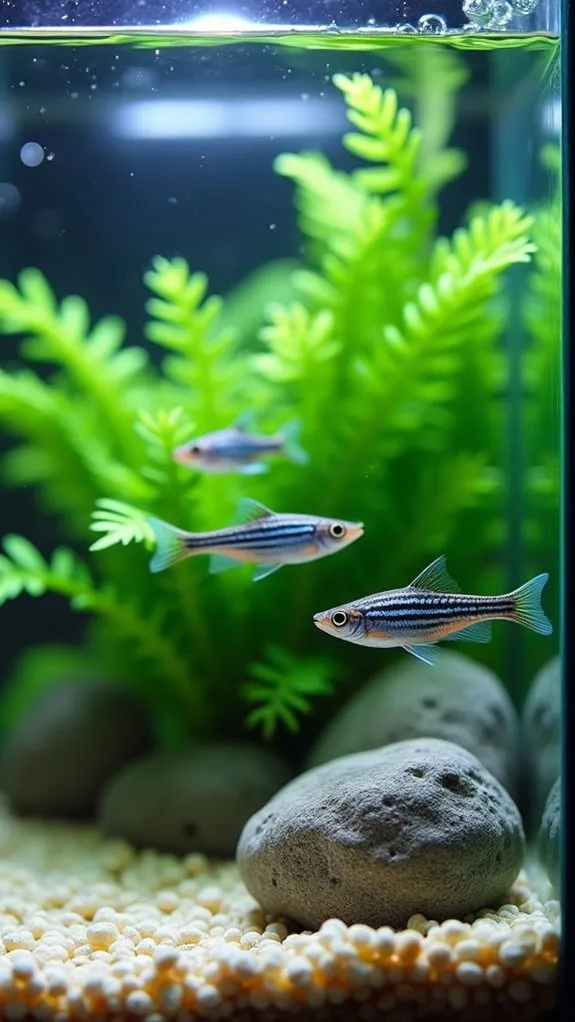
The key to low-maintenance fish keeping lies in proper water quality management. While you might think this sounds complicated, it's actually quite straightforward when you focus on the basics.
Regular water testing and reliable filtration systems are your best friends in keeping your aquatic pets healthy and happy without spending hours on maintenance.
To make your life easier, here are the essential aspects of water quality management that'll help you maintain a thriving aquarium:
- Monitor temperature consistently – it's vital for your fish's metabolism and overall health
- Perform partial water changes of no more than 1/3 of the tank volume every few weeks
- Keep your filtration system clean and running efficiently
You don't need to be a water chemistry expert to succeed. Just remember that stable conditions are more important than perfect ones. Maintaining proper ammonia levels is crucial for fish health and can prevent many common issues.
Your fish will do just fine if you maintain consistent temperature levels and keep ammonia below 0.5 mg/l. Think of it like maintaining your home's temperature – you wouldn't want sudden changes there either!
With a good filtration system and regular testing routine, you'll spend less time worrying and more time enjoying your underwater friends.
Best Fish Tank Combinations
Creating successful fish tank combinations requires understanding which species naturally complement each other. When you're looking for ideal fish compatibility, several pairings stand out for their harmonious relationships and stunning tank aesthetics.
For a low-maintenance setup, you can't go wrong with guppies and tetras. These hardy fish will make your tank come alive with their vibrant colors, and they're perfect if you're just starting your aquarium journey.
If you're working with a smaller tank, consider pairing a betta fish with harlequin rasboras – they'll create a peaceful community while adding visual interest to your aquatic display.
For those with larger tanks, try the striking combination of angelfish, mollies, and zebra danios. You'll love watching the majestic angelfish glide through the water while the energetic danios zip around them.
If you're seeking a balanced ecosystem, corydoras and platies make excellent tankmates. The corydoras will help keep your tank clean by scavenging the bottom, while the colorful platies add life to the middle water column. Additionally, it's important to monitor water parameters to ensure the health of your fish and maintain a thriving habitat.
These combinations guarantee both beautiful aesthetics and happy, stress-free fish.
Daily Care Routines
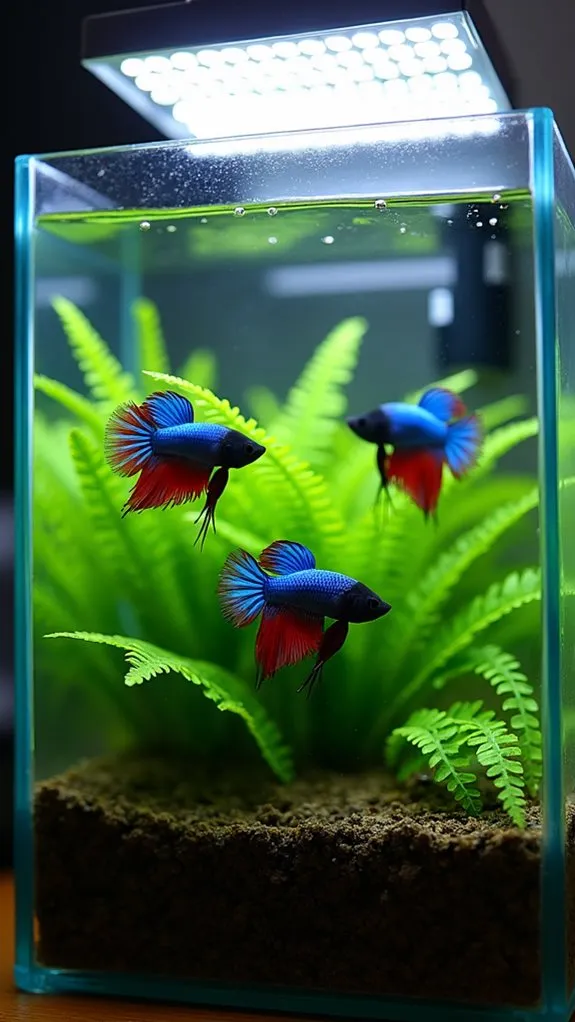
What Are the Least Maintenance Fish?
Daily Care Routines
Once you've set up your ideal fish combinations, successful aquarium care hinges on consistent daily routines.
You'll need to monitor water quality regularly and observe fish behavior to confirm your aquatic friends are thriving. Though low-maintenance fish are hardy, they still depend on you to maintain their environment through simple daily tasks.
Your daily care routine doesn't have to be complicated.
Focus on these essential practices that'll keep your fish healthy and happy:
- Check your filter's operation and water temperature each morning – it's as easy as glancing at your tank while sipping your coffee.
- Feed your fish appropriate portions once or twice daily, watching their behavior during meals to spot any health issues early.
- Perform quick visual inspections of the tank walls and decorations for algae buildup. Maintaining optimal water quality is crucial for preventing health problems in your fish.
Remember to schedule your bigger maintenance tasks, like water changes and filter cleaning, on a weekly or monthly basis.
By maintaining consistent routines, you'll spend less time troubleshooting problems and more time enjoying your peaceful underwater world.
Plus, when you stick to regular maintenance schedules, you'll quickly notice if something's not quite right with your fish or their environment.
Disease Prevention Tips
Keeping your fish healthy starts with proactive disease prevention strategies. You'll want to establish a solid quarantine protocol for any new fish you bring home, giving you time for disease identification and monitoring their behavior in a separate tank.
Think of it as a fish's mini wellness retreat before joining their new community!
One of your best defenses against disease is maintaining pristine water conditions. Regular water changes, proper filtration, and avoiding overcrowding will greatly reduce the risk of illness in your aquatic pets. In addition, regular testing of water parameters ensures that ammonia and nitrite levels remain safe for your fish.
Don't forget to wash your hands thoroughly before and after tank maintenance – your fish will thank you for it!
When it comes to treatment options, you've got choices that won't break the bank or harm your fish. Natural remedies like MELAFIX and PIMAFIX can effectively treat minor bacterial and fungal infections without harsh chemicals.
You'll also want to keep an eye out for early warning signs, such as changes in eating habits or unusual swimming patterns.
Schooling Fish Benefits
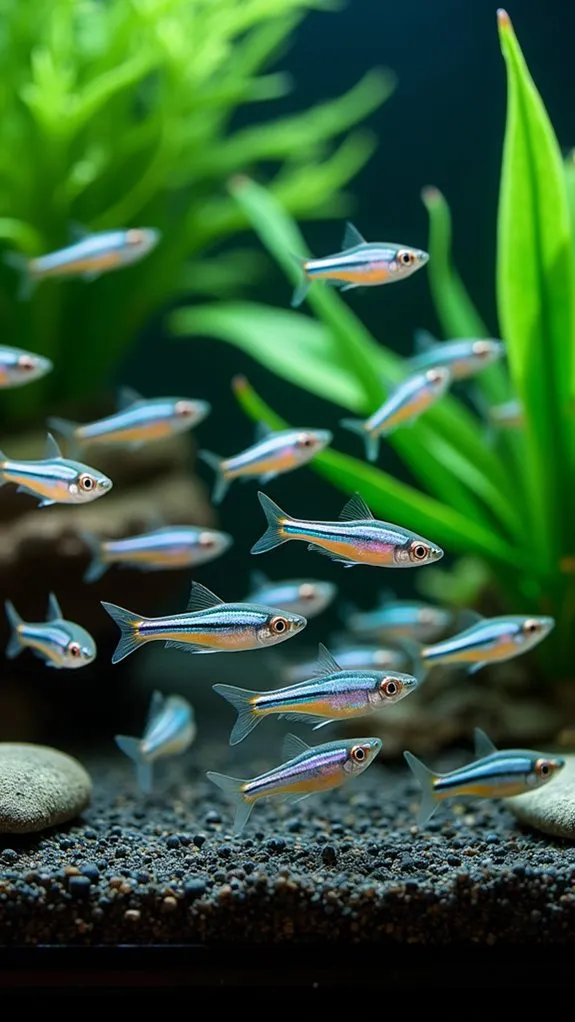
When you maintain proper schooling behavior, you'll notice your fish display more vibrant colors, synchronized swimming patterns, and reduced stress levels. The group dynamics create a peaceful environment where fish can establish natural hierarchies without aggressive competition.
You'll love watching these synchronized swimmers transform your aquarium into a mesmerizing display while enjoying these key advantages:
- Lower maintenance requirements since happy, grouped fish have stronger immune systems and better disease resistance.
- Enhanced visual appeal through coordinated movements that create stunning, natural patterns.
- Reduced aggression in your tank as schooling fish help maintain peace among other species. Additionally, ensuring proper filtration systems can further improve the water quality and overall health of your aquarium.
Seasonal Care Guidelines
You are trained on data up to October 2023. Successfully caring for low-maintenance fish requires adapting your care routine to seasonal changes throughout the year. While these hardy fish may be easier to maintain, you'll still need to make adjustments as the seasons shift to keep your aquatic friends healthy and happy.
Your seasonal fish care should focus primarily on temperature management. During winter, you'll want to maintain stable temperatures using reliable heaters, typically keeping tropical fish between 75-80°F and cold-water fish around 65-70°F.
As spring arrives, you'll need to do a thorough cleaning and gradually adjust feeding schedules – think of it as your fish's version of spring cleaning! It's important to remember that dissolved oxygen levels can be affected by temperature changes, so monitor these closely during your cleaning.
Summer brings its own challenges, and you'll need to prevent overheating by keeping tanks away from direct sunlight and using chillers if necessary.
Year-round, you'll want to perform regular water changes and testing, but the frequency might change with the seasons.
Don't forget to adjust your feeding schedule too – fish tend to eat less in winter when their metabolism slows down, and more in warmer months when they're more active.
Frequently Asked Questions
Can Low-Maintenance Fish Recognize Their Owners?
Yes, your low-maintenance fish can recognize you through consistent owner interaction. Their fish behavior includes remembering faces, routines, and responding to your presence, though recognition abilities vary among different species.
Do These Fish Need Additional Lighting Besides Room Light?
You don't need extra lighting if you've got good natural light and smart tank placement. Most low-maintenance fish do fine with room light, as long as you maintain a consistent day-night cycle for them.
How Long Do Most Low-Maintenance Fish Typically Live?
You'll find that most common low-maintenance fish live 3-5 years, though lifespan factors like water quality and diet can affect fish longevity. Some hardier species like goldfish can survive 10+ years with care.
Can Low-Maintenance Fish Breed Easily in Home Aquariums?
Yes, you'll find many low-maintenance fish breed readily in home aquariums. Just guarantee proper breeding conditions, including stable water parameters and appropriate tank setup with hiding spots and plants for the fry.
Should Low-Maintenance Fish Be Quarantined Before Joining Existing Tanks?
Yes, you should always quarantine new fish, even low-maintenance ones, for at least four weeks. It's essential for preventing fish diseases and protecting your existing aquarium. The quarantine benefits far outweigh the extra effort.
Final Thoughts
You'll find that low-maintenance fish can bring joy to your home without overwhelming your schedule. Whether you've chosen peaceful bettas, hardy guppies, or resilient tetras, remember that success comes from proper tank setup, consistent feeding, and regular water changes. While these fish are easier to care for, they still deserve your attention and love. With the right knowledge and minimal daily effort, you'll create a thriving aquatic paradise.
